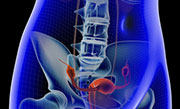- Skip Storing This Everyday Product in the Fridge Door
- Green Tea + B3 Pairing May Boost Brain Health
- Navigating Your Midlife Crisis: Embracing New Possibilities
- City Raccoons Showing Signs of Domestication
- Mapping the Exposome: Science Broadens Focus to Environmental Disease Triggers
- One Week Less on Social Media Linked to Better Mental Health
- Your Brain Changes in Stages as You Age, Study Finds
- Some Suicide Victims Show No Typical Warning Signs, Study Finds
- ByHeart Formula Faces Lawsuits After Babies Sickened With Botulism
- Switch to Vegan Diet Could Cut Your Greenhouse Gas Emissions in Half
Low Cancer Risk With Device Used to Remove Fibroids, Study Finds


A small power tool that is sometimes used to remove fibroids in the uterus can end up spreading bits of hidden cancerous tumors throughout the abdomen, but a new study suggests the likelihood is low.
Researchers called the findings, reported online Feb. 19 in JAMA Oncology, “reassuring.” But the device, called a power morcellator, remains under restricted use.
Until recently, doctors commonly used power morcellators during minimally invasive surgery to remove uterine fibroids — non-cancerous growths in the wall of the uterus.
Fibroids are very common, but some women eventually need surgery to put an end to symptoms like pelvic pain and heavy menstrual bleeding. Doctors can either remove the fibroids or perform a hysterectomy to remove the uterus.
The power morcellator has a rotating blade that breaks apart fibroid growths or, during a hysterectomy, the uterus itself. The tissue can then be removed through tiny incisions.
But last November, the U.S. Food and Drug Administration issued a strong “boxed” warning on the devices — saying that if a woman has an undetected cancerous uterine tumor, the morcellator could spread and worsen the cancer.
The agency said that for most women with fibroids, the device should not be used — including women who are going through or have gone through menopause, since older age increases the risk of uterine cancer.
But the FDA said some younger women might still be candidates for having fibroids removed with the device.
The new study was done to get a handle on how many women having fibroids removed — but not the uterus — might have hidden cancer, explained lead researcher Dr. Jason Wright, chief of gynecologic oncology at Columbia University, in New York City.
His team looked at records for almost 42,000 U.S. women who had fibroids surgically removed between 2006 and 2012. A power morcellator was used in just over 3,200 cases.
Of those women who were treated with a morcellator, three were later found to have uterine cancer — a rate of one in slightly over 1,000 patients. (When fibroids are removed, they are typically sent for testing to confirm whether they are, in fact, benign.)
By comparison, the odds of uterine cancer were one in 528 among women who had fibroids removed without the device.
As expected, the likelihood of a hidden cancer increased with age: Of women younger than 40 who had power morcellation, none were found to have uterine cancer; the rate increased to almost 1 percent among women in their 50s.
“Overall, the risk is low, and I think that’s reassuring,” Wright said.
He noted that the results are also in line with the FDA’s recommendations for older and younger women.
It’s not clear how often power morcellation is still being used, according to Wright. After the FDA began investigating the devices, the leading manufacturer — Johnson & Johnson — pulled its products from the market in July. And some U.S. hospitals have reportedly banned their use.
The most important message for women is that they have other options for fibroid removal, said Dr. Ceana Nezhat, a surgeon at the Atlanta Center for Minimally Invasive Surgery and Reproductive Medicine.
“The restrictions on power morcellation do not mean that women should have more hysterectomies, or not have minimally invasive surgery,” said Nezhat, who wrote an editorial published with the study.
Uterine fibroids can be removed through small incisions, even without morcellation, Nezhat noted.
However, Wright pointed out, that does depend on factors such as how many fibroids a woman has, and the size of the growths. So for some younger women, power morcellation might still be recommended.
“I think that women should ask questions, no matter what [procedure] the doctor recommends, and make sure they understand the potential risks and benefits,” Wright said.
According to the U.S. Department of Health and Human Services, up to 80 percent of women develop fibroids — most often in their 40s and early 50s. Sometimes the growths cause no symptoms, but in other cases they cause pelvic or low back pain, heavy menstrual bleeding or frequent urination because of pressure on the bladder.
Short of surgery, women can take pain relievers to treat symptoms, or hormonal drugs that can help shrink the fibroids. Other invasive procedures include endometrial ablation — where the lining of the uterus is removed — and embolization, which cuts off the blood supply to fibroids.
More information
The U.S. Department of Health and Human Services has more on uterine fibroids.
Source: HealthDay
Copyright © 2025 HealthDay. All rights reserved.










